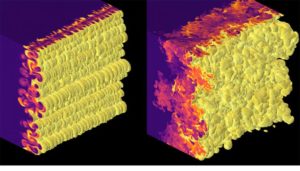Inertial confinement fusion (ICF) experiments is a speculative method of fusion energy generation that would compress a fuel pellet to generate fusion energy just before its explosion. This method of power generation, of course, involves a vast array of forces at work – and now, researchers at Lawrence Livermore National Laboratory are using supercomputing to better understand those forces.
The research specifically examined two kinds of instability: Rayleigh-Taylor instability, through which less-dense materials, if misaligned, slowly return to a stable state relative to more-dense materials; and Richtmyer-Meshkov instability, through which a shockwave causes two fluids to rapidly interface. And, even more specifically, the research focused on how those instabilities operate in high-energy-density (HED) conditions.
The LLNL study used 3D radiation hydrodynamics simulations to see how mixing under HED conditions was different from mixing in non-HED conditions. To run these intensive simulations, the researchers turned to in-house supercomputing at LLNL: the RZTopaz cluster, an Intel Xeon-based system that delivers just under one peak petaflops and is a part of the Open Computing Facility (OCF) at Livermore Computing.
Using over 2.9 million core hours on RZTopaz, the team was able to identify common trends between the HED and non-HED mixing layers – as well as trends unique to HED layers.

“We calculate that the impact of a second shock or ‘reshock’ on the HED mixing layers increases turbulent kinetic energy by over one order of magnitude, similar to what has been found in non-HED scenarios,” explained Jason Bender, the LLNL physicist who led the study, in an interview with LLNL’s Michael Padilla. “Conversely, we highlight two trends that are unique to the HED regime. First, we show that, during reshock, the generation of vorticity – a key quantity in fluid mechanics – includes a substantial contribution associated with dilatation.”
Now, the results of the team’s simulations are being used to inform the design of experimental ICF capsules and interpret results from those experiments. The researchers are also proud of their paper, which they consider to be a high-quality reference work for people interested in the subdomain.
“The study was driven by a strong educational motivation,” he said. “The paper was written to be a comprehensive guide to modern simulation of HED instability growth and mixing, accessible both to ICF scientists and to experts in traditional non-HED fluid mechanics. All governing equations and key physical models are documented and described with citations to more than 140 references.”
That paper, titled “Simulation and flow physics of a shocked and reshocked high-energy-density mixing layer,” was published in the March 2021 issue of the Journal of Fluid Mechanics and can be accessed here.
To learn more, read Michael Padilla’s coverage here.




























































